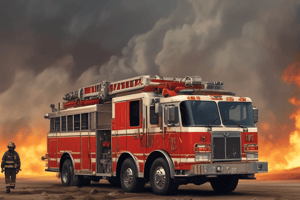Podcast
Questions and Answers
What is the primary purpose of identifying the type and number of stairwells in a high-rise building?
What is the primary purpose of identifying the type and number of stairwells in a high-rise building?
- To identify the location of the fire
- To determine the best exit route for civilians
- To determine the number of firefighters needed for the operation
- To implement an Incident Action Plan (IAP) effectively (correct)
What is the characteristic design of Return Stairwells?
What is the characteristic design of Return Stairwells?
- The stairwell has a straight design
- The stairwell entry and exit points are directly above or below each other (correct)
- The stairwell entry and exit points are on opposite sides of the building
- The stairwell has a spiral design
What is the typical location of the landing in a Return Stairwell?
What is the typical location of the landing in a Return Stairwell?
- At the bottom of the stairwell
- At the middle of the U-shape
- At the top of the stairwell
- Half way between the floors (correct)
Why is it essential to designate stairwells early in the incident?
Why is it essential to designate stairwells early in the incident?
What is the preferred apparatus for designating stairwells?
What is the preferred apparatus for designating stairwells?
What is the primary function of stairwells in firefighting operations?
What is the primary function of stairwells in firefighting operations?
What is a distinct feature of scissor stairs?
What is a distinct feature of scissor stairs?
What is the primary purpose of access stairs?
What is the primary purpose of access stairs?
What is a key consideration when designating a stairwell for attack?
What is a key consideration when designating a stairwell for attack?
What is the purpose of maintaining at least one stairwell free of smoke and heat?
What is the purpose of maintaining at least one stairwell free of smoke and heat?
What distinguishes an attack stairwell from other types of stairwells?
What distinguishes an attack stairwell from other types of stairwells?
What is a key aspect of tactical use of stairs?
What is a key aspect of tactical use of stairs?
What is the purpose of pressurizing stairwells in high-rise buildings during a fire?
What is the purpose of pressurizing stairwells in high-rise buildings during a fire?
Why is it recommended to take a few seconds to adjust PPE when ascending above ten floors?
Why is it recommended to take a few seconds to adjust PPE when ascending above ten floors?
What is the recommended procedure for removing gear when ascending stairs?
What is the recommended procedure for removing gear when ascending stairs?
What is the purpose of assigning a firefighter every two floors in the stairwell?
What is the purpose of assigning a firefighter every two floors in the stairwell?
What happens if no one is available to receive equipment on a higher floor during a shuttle operation?
What happens if no one is available to receive equipment on a higher floor during a shuttle operation?
What do firefighters do after handing off equipment during a shuttle operation?
What do firefighters do after handing off equipment during a shuttle operation?
Flashcards are hidden until you start studying
Study Notes
Stairwells in High-Rise Buildings
- Stairwells are a vital part of firefighting operations, serving as a primary means of evacuation, fire attack, ventilation, and access.
- Identifying the type and number of stairs within a high-rise building is crucial for implementing an Incident Action Plan (IAP).
Types of Stairwells
- Return Stairwells: the most common type in high-rise buildings, designed in a U-shape with stairwell entry and exit points directly above or below each other.
- Scissor Stairwells: consist of two separate stairwells contained in one vertical shaft, separated by a fire-rated wall, and exit on the opposite side of the building at each landing.
- Access Stairwells (also known as Tenant Stairs or Convenience Stairs): provide access between floors of individual occupancies.
Tactical Use of Stairs
- Designating stairwells for attack and evacuation at the onset of an operation is crucial for firefighter safety and civilian occupant survivability.
- Attack Stairwell: selected based on the location of the fire, standpipe, and stairwells being used by occupants for evacuation.
- Evacuation Stairwell: at least one stairwell must be maintained free of smoke and heat for occupant evacuation.
Stairwell Pressurization
- Some modern high-rise buildings are equipped with a feature that pressurizes the stairwells in the event of a fire or upon activation of the fire alarm system.
- This feature is designed to keep the stairwells clear of smoke and heat when doors at the fire floor are opened.
Ascending Stairs
- Ascending an excessive number of floors can cause unnecessary stress on the body.
- When ascending above ten floors in a non-IDLH atmosphere, crews should take a few seconds to adjust their PPE
- Open or remove bunker jacket
- Remove gloves and hood
- Clip helmet to SCBA harness
- Raise bunker pant cuffs above boots
- Carry tools above the waist
Equipment Shuttle in the Stairwell
- If elevators fail, a firefighter should be placed every two floors to assist in shuttling equipment.
- Firefighters are assigned to retrieve equipment from apparatus and gather equipment near the stairwell entrance for the start of the shuttle.
- After 'handing off' equipment, the firefighter must descend back to their starting level. If no one is at the higher level to take the hand-off, the equipment shall be left on the stairwell landing.
Studying That Suits You
Use AI to generate personalized quizzes and flashcards to suit your learning preferences.




